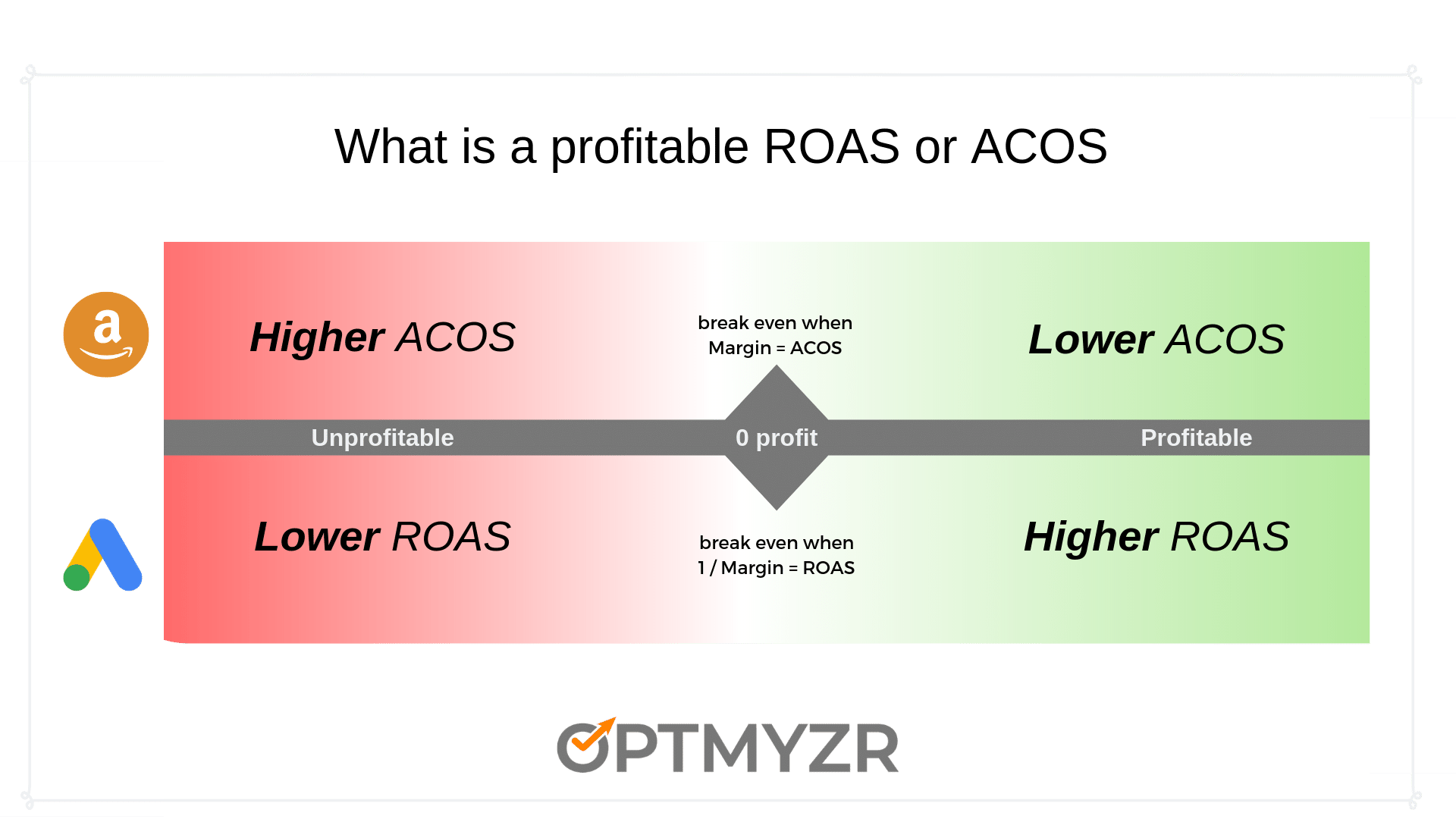Online advertising can get expensive but thankfully the ad engines like Google, Bing and Amazon all have controls that help advertisers keep costs at the right level for their business goals.
In this post I’ll share how to use your profit margin in conjunction with either target ROAS (tROAS) or target ACOS (tACOS) to achieve break-even on your ad spend. Once you know how to pick the right target so you don’t lose money on PPC, you can dial it up or down to find the right balance between profits and revenue.
The Difference Between Google ROAS and Amazon ACOS
First let’s take a look at what ROAS and ACOS mean and how they are calculated.
Google uses ROAS
When it comes to reporting columns, Google uses terms like ‘Conv. value / cost’ or ‘All conv. Value / cost’. ROAS (return on ad spend) isn’t a metric you can pick:
But the good news is that ROAS is simply one of the ratios expressed as a percentage so it’s just multiplied by 100 and a ‘%’ sign is slapped on the back:
Google does use the term ROAS in one of its automated bid strategies: Target ROAS (tROAS).
Amazon uses ACOS
Amazon shows the ACOS (advertising cost of sales) metric in its interface more prominently so advertisers are immediately exposed to it when they start advertising on Amazon.
ACOS is based on two of the other metrics Amazon shows by default in its interface:
Are ACOS and ROAS related?
ACOS and ROAS both serve the same purpose of giving guidance on how to make online ads profitable but at first glance the two metrics seem very different:
While the formulas look quite different, that’s mostly due to the difference in nomenclature between the two ad platforms. Where Google calls it ‘cost’, Amazon calls it ‘Ad Spend’.
Google cost = Amazon ad spend
Where Google calls it ‘Conversion Value’, ‘Conv. Value’, or ‘Value’, Amazon calls it ‘Sales’.
Google Conversion Value = Amazon Sales
So once we standardize the terminology and swap out all the synonyms, we see that ROAS is the inverse of ACOS:
We need to know product profit margin before ACOS and ROAS become useful.
So how are ACOS and ROAS helpful in bid management? How might we decide what a good target ROAS or target ACOS might be? To do that, we need to understand margins.
Product profit margin or gross profit margin is the ratio of profit over revenue for a single product. The simplest way to think of profit is as the value of the sale minus the cost of producing the thing that was sold:
Let’s look at an example where we sell 3 products for the same price but they all cost different amounts to make. Or for an Amazon reseller, they all cost a different amount to buy from the manufacturer:
Combine margin with ROAS or ACOS to find your break-even point
Now we have all the pieces needed to find how much we can spend on advertising to break even on each sale or conversion*.
To make sure we don’t lose money by buying ads, our ad spend to get a sale should be no more than the profit we get from that sale.
We make a profit when:
profit on the item sold >advertising cost to get the sale
That’s simple logic to understand, but to communicate this goal to the ad engines, we need to translate it into the jargon they use. That means we need to bring it back to ROAS and ACOS.
What is a Break-Even ACOS
ACOS it’s very simple to equate to break-even if you know your margin. The numbers have to be the same.
- If ACOS is lower than the product margin, we make money.
- If ACOS is higher than the product margin, we lose money.
What is a break-even ROAS?
Because ROAS and ACOS are the inverse of each other, our break-even point on Google is when is (product profit margin)-1 . That’s the product margin divided by 1.
- If ROAS is lower than 1 / product margin, we lose money.
- If ROAS is higher than 1 / product margin, we make money.
Let’s see that in a different more visual way:

The bottom line
So there you have it, the perfect ACOS or ROAS to break-even on your ad spend on Google or Amazon. On Amazon, it’s the profit margin of the product you sell. On Google it’s the inverse of that same number.
*You don’t really break even by spending no more on ads to get a sale than what you gain from that sale as that doesn’t consider other costs to run the business of selling things. This is why knowing the break-even point is just the start and you should add a target profitability so you make money.








